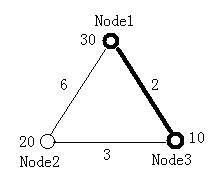Minimal Ratio Tree
Time Limit: 2000/1000 MS (Java/Others) Memory Limit: 32768/32768 K (Java/Others)
Total Submission(s): 2180 Accepted Submission(s): 630
Problem Description
For a tree, which nodes and edges are all weighted, the ratio of it is calculated according to the following equation.

Given a complete graph of n nodes with all nodes and edges weighted, your task is to find a tree, which is a sub-graph of the original graph, with m nodes and whose ratio is the smallest among all the trees of m nodes in the graph.

Given a complete graph of n nodes with all nodes and edges weighted, your task is to find a tree, which is a sub-graph of the original graph, with m nodes and whose ratio is the smallest among all the trees of m nodes in the graph.
Input
Input contains multiple test cases. The first line of each test case contains two integers n (2<=n<=15) and m (2<=m<=n), which stands for the number of nodes in the graph and the number of nodes in the minimal ratio tree. Two zeros end the input. The next line contains n numbers which stand for the weight of each node. The following n lines contain a diagonally symmetrical n×n connectivity matrix with each element shows the weight of the edge connecting one node with another. Of course, the diagonal will be all 0, since there is no edge connecting a node with itself.
All the weights of both nodes and edges (except for the ones on the diagonal of the matrix) are integers and in the range of [1, 100].
The figure below illustrates the first test case in sample input. Node 1 and Node 3 form the minimal ratio tree.

All the weights of both nodes and edges (except for the ones on the diagonal of the matrix) are integers and in the range of [1, 100].
The figure below illustrates the first test case in sample input. Node 1 and Node 3 form the minimal ratio tree.

Output
For each test case output one line contains a sequence of the m nodes which constructs the minimal ratio tree. Nodes should be arranged in ascending order. If there are several such sequences, pick the one which has the smallest node number; if there's a tie, look at the second smallest node number, etc. Please note that the nodes are numbered from 1 .
Sample Input
3 2
30 20 10
0 6 2
6 0 3
2 3 0
2 2
1 1
0 2
2 0
0 0
Sample Output
1 3
1 2
Source
这道题是2008年北京现场比赛的一道题,题意大致意思是给定n个节点的一个图,要你从中选出这小边的权值和除以节点权值和的最小的一个树
于是很好理解的为最小生成树,采用普利姆最小生成树....注意精度的问题,这里我wa了n次
哎,喵了个咪
代码:
1 #include<string.h> 2 #include<stdlib.h> 3 #include<stdio.h> 4 #include<math.h> 5 #define max 0x3f3f3f3f 6 #define maxn 17 7 int node_weight[maxn]; 8 int edge_weight[maxn][maxn]; 9 int depath[maxn]; //以这些点形成一颗最小生成树 10 int m , n ; 11 double res; 12 int stu[maxn]; 13 int sub_map[maxn][maxn]; 14 void Prime() 15 { 16 int vis[maxn]={0}; 17 int lowc[maxn]; 18 int i,j,k,minc; 19 double ans=0; 20 for(i=1;i<=m;i++) //从n中挑出m个点形成一个子图 21 { 22 for(j=1;j<=m;j++) 23 { 24 if(edge_weight[depath[i]][depath[j]]==0) 25 sub_map[i][j]=max; 26 else 27 sub_map[i][j]=edge_weight[depath[i]][depath[j]]; 28 } 29 } 30 vis[1]=1; 31 for(i=1;i<=m;i++) 32 { 33 lowc[i]=sub_map[1][i]; 34 } 35 for(i=2;i<=m;i++) 36 { 37 minc=max; 38 k=0; 39 for(j=2;j<=m;j++) 40 { 41 if(vis[j]==0&&minc>lowc[j]) 42 { 43 minc=lowc[j]; 44 k=j; 45 } 46 } 47 if(minc==max) return ; //表示没有联通 48 ans+=minc; 49 vis[k]=1; 50 for(j=1 ; j<=m;j++) 51 { 52 if(vis[j]==0&&lowc[j]>sub_map[k][j]) 53 lowc[j]=sub_map[k][j]; 54 } 55 } 56 int sum=0; 57 for(i=1;i<=m;i++) //统计点权值的和 58 sum+=node_weight[depath[i]]; 59 ans/=sum; 60 if(res+0.00000001>=ans) 61 { 62 if((res>=ans&&res<=ans+0.000001)||(res<=ans&&res+0.000001>=ans+0.000001)) 63 { 64 for(i=1;i<=m;i++) 65 { 66 if(stu[i]<depath[i]) return; 67 } 68 } 69 res=ans; 70 memcpy(stu,depath,sizeof(depath)); 71 } 72 } 73 void C_n_m(int st ,int count) 74 { 75 if(count==m) 76 { 77 Prime(); 78 return ; 79 } 80 for(int i=st ;i<=n;i++ ) 81 { 82 depath[count+1]=i; 83 C_n_m(i+1,count+1); 84 } 85 } 86 int main() 87 { 88 int i,j; 89 while(scanf("%d%d",&n,&m),m+n) 90 { 91 for(i=1;i<=n;i++) 92 scanf("%d",node_weight+i); //记录节点权值 93 for(i=1;i<=n;i++) //记录边权值 94 for(j=1;j<=n;j++) 95 scanf("%d",&edge_weight[i][j]); 96 // C(n,m) 97 res=max; 98 C_n_m(1,0); 99 for(i=1;i<=m;i++) 100 { 101 printf("%d",stu[i]); 102 if(i!=m)printf(" "); 103 } 104 putchar(10); 105 } 106 return 0; 107 }